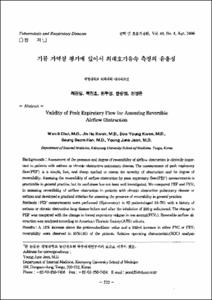KUMEL Repository
1. Journal Papers (연구논문)
1. School of Medicine (의과대학)
Dept. of Internal Medicine (내과학)
기류 가역성 평가에 있어서 최대호기유속 측정의 유용성
- Keimyung Author(s)
- Choi, Won Il; Han, Sung Beom; Jeon, Young June
- Department
- Dept. of Internal Medicine (내과학)
- Journal Title
- 결핵 및 호흡기 질환
- Issued Date
- 2000
- Volume
- 48
- Issue
- 4
- Abstract
- Backgrounds : Assessment of the presence and degree of reversibility of airflow obstruction is clinically important in patients with asthma or chronic obstructive pulmonary disease. The measurement of peak expiratory flow(PEF) is a simple, fast, and cheap method to assess the severity of obstruction and its degree of reversibility. Assessing the reversibility of airflow obstruction by peak expiratory flow(PEF) measurements is practicable in general practice, but its usefulness has not been well investigated. We compared PEF and $FEV_1$ 수식 이미지 in assessing reversibility of airflow obstruction in patients with chronic obstructive pulmonary disease or asthma and developed a practical criterion for assessing the presence of reversibility in general practice. Methods : PEF measurements were performed (Spirometry) in 80 patients(aged 24-78) with a history of asthma or chronic obstructive lung disease before and after the inhalation of 200 g salbutamol. The change in PEF was compared with the change in forced expiratory volume in one second($FEV_1$ 수식 이미지). Reversible airflow obstruction was analyzed according to American Thoracic Society(ATS) criteria. Results : A 12% increase above the prebronchodilator value and a 200ml increase in either FVC or $FEV_1$ 수식 이미지 reversibility were observed in 45%(36) of the patients. Relative operating characteristic(ROC) analysis showed that an absolute improvement in PEF of 30 l/min gave optimal discrimination between patients with reversible and irreversible airflow obstruction(the sensitivity and specificity of an increase of 30 l/min in detecting a 12% increase above the prebronchodilator value and a 200ml increase in either FVC or $FEV_1$ 수식 이미지 were 72.2% and 72.7% respectively, with a positive predictive value of 68.4%). Conclusions : Absolute changes in PEF can be used to diagnose reversible airflow obstruction.
키워드
Peak expiratory flow(PEF); $FEV_1$ 수식 이미지; Reversibility of airflow obstruction
목 적 : 최대호기유속 측정도 $FEV_1$ 수식 이미지과 함께 기도폐색의 정도를 평가할 수 있으며 기도폐색의 가역성을 평가하는 것은 기도폐쇄질환 환자들의 진단 및 치료에 중요하다. 최대호기유속은 $FEV_1$ 수식 이미지에 비해 측정이 간단하며 쉽고 빠르게 검사할 수 있는 장점이 있어 1차 진료기관에서도 쉽게 이용할 수 있다. 그러나 최대호기유속으로 기류 가역성을 평가한 연구는 매우 적다. 이에 천식 및 만성폐쇄성폐질환 환자들에게서 최대호기유속과 $FEV_1$ 수식 이미지으로 기류 가역성올 비교 평가하여 1차 진료기관에서 최대호기유속을 측정함으로써 기류 가역성을 평가하는데 기준을 마련하고자 본 연구를 시행하였다. 방 법 : 본 연구는 호흡곤란, 기침 및 천명을 주소로 계명대학교 동산병원 호흡기내과를 방문한 환자들 중 천식 및 만성폐쇄성폐질환으로 진단 받은 80명의 환자들을 대상으로 조사하였다. 베타-2 교감신경작용제(salbutamol) 흡입 직전과 15분 후 측정한 $FEV_1$ 수식 이미지의 추정정상치가 12% 이상 증가하고 노력성폐활량 또는 $FEV_1$ 수식 이미지의 절대값이 200ml 이상 증가한 경우를 기류가역성이 있는 것으로 정의하였다. 최대호기유속의 가역성은 베타-2 교감신경작용제 사용 후 절대값의 변화(1/min)로 표현하였으며 최대호기유속의 절대값의 변화에 따른 기류폐색의 가역성 평가에 대한 민감도, 특이도, 양성예측율과 음성예측율을 구하였다. 결 과 : 대상환자 80명중 36명(45%)에서 기류 가역성이 있었다. 폐활량측정법으로 기류 가역성이 증명된 환자에서 최대호기유속으로 기류 가역성을 평가하여서 최대호기유속의 민감도, 특이도, 양성예측을 그리고 음성예측율을 구하였을때 기저치보다 30 l/min 이상 증가한 경우에 가장 높게 관찰되었고 민감도 72.2%, 특이도 72.7%, 양성예측율 68.4% 그리고 음성예측율은 76.2%로 관찰되었다. 결 론 : 이상의 결과로 베타-2 교감신경작용제 사용 후 최대호기유속의 절대값의 변화는 기류 가역성을 평가하는데 간편하고 효율적인 방법으로 생각된다.
- Alternative Title
- Validity of Peak Expiratory Flow for Assessing Reversible Airflow Obstruction
- Publisher
- School of Medicine
- Citation
- 최원일 et al. (2000). 기류 가역성 평가에 있어서 최대호기유속 측정의 유용성. 결핵 및 호흡기 질환, 48(4), 522–529. doi: 10.4046/trd.2000.48.4.522
- Type
- Article
- ISSN
- 1738-3536
- Appears in Collections:
- 1. School of Medicine (의과대학) > Dept. of Internal Medicine (내과학)
- 파일 목록
-
-
Download
 oak-bbb-00172.pdf
기타 데이터 / 521.32 kB / Adobe PDF
oak-bbb-00172.pdf
기타 데이터 / 521.32 kB / Adobe PDF
-
Items in Repository are protected by copyright, with all rights reserved, unless otherwise indicated.